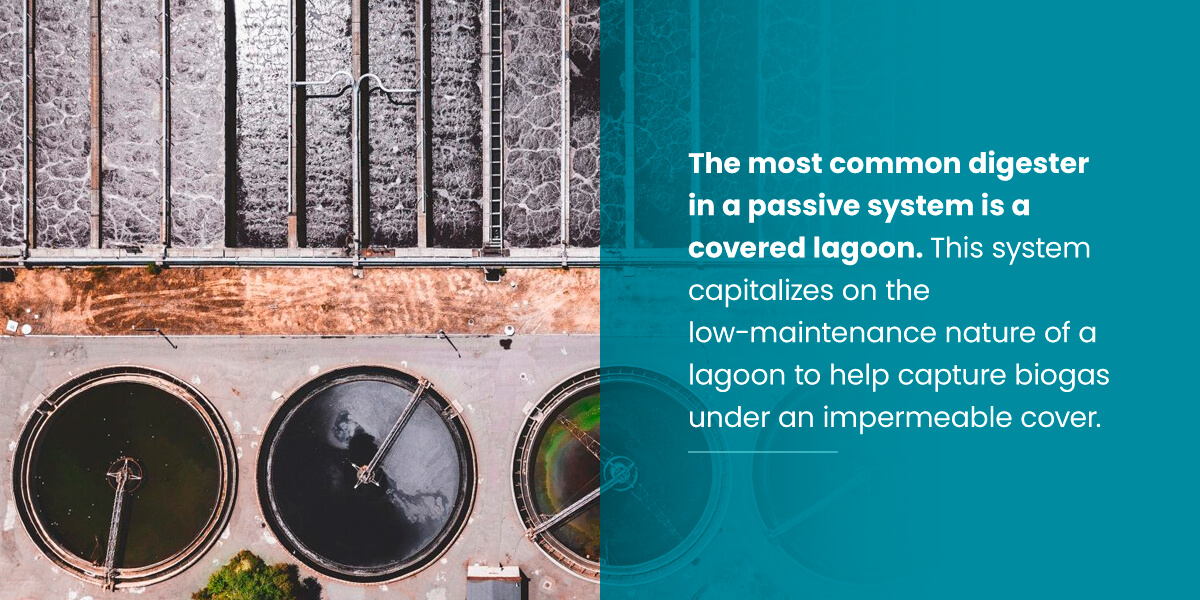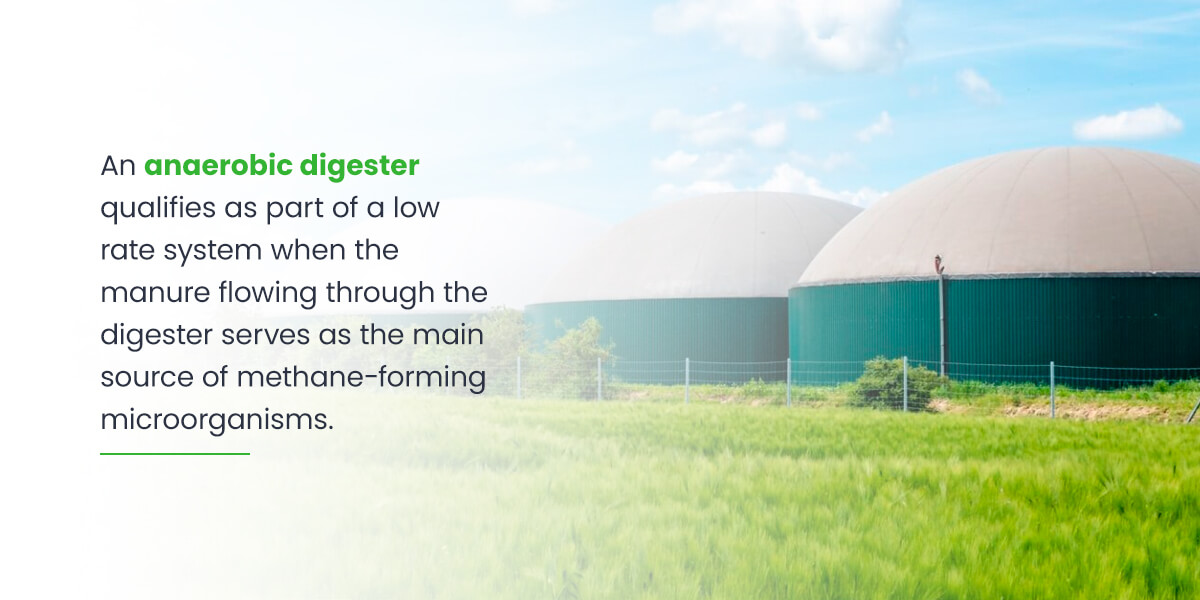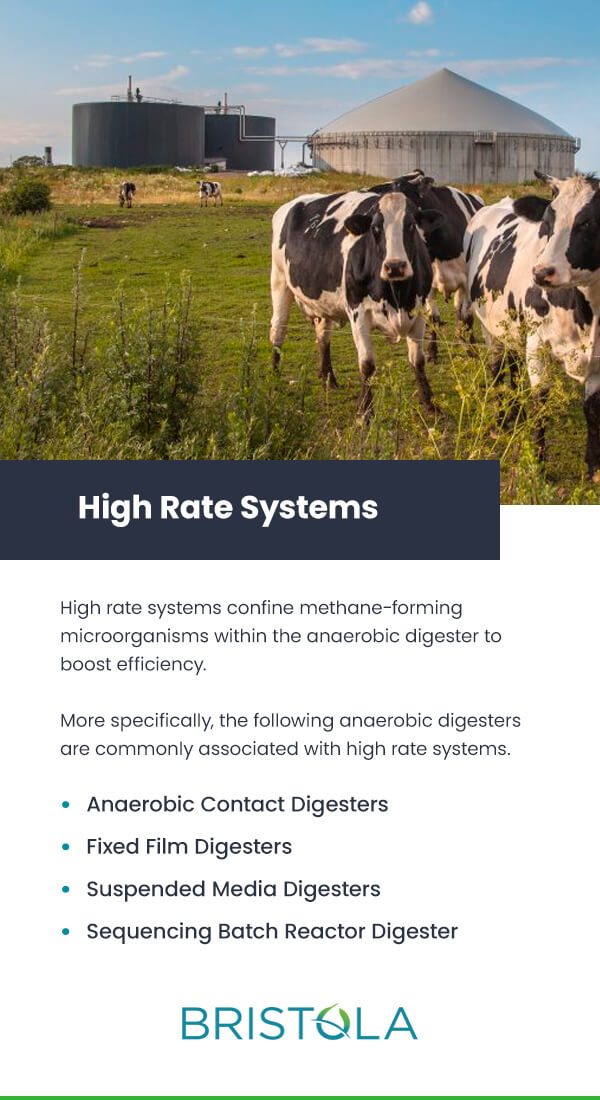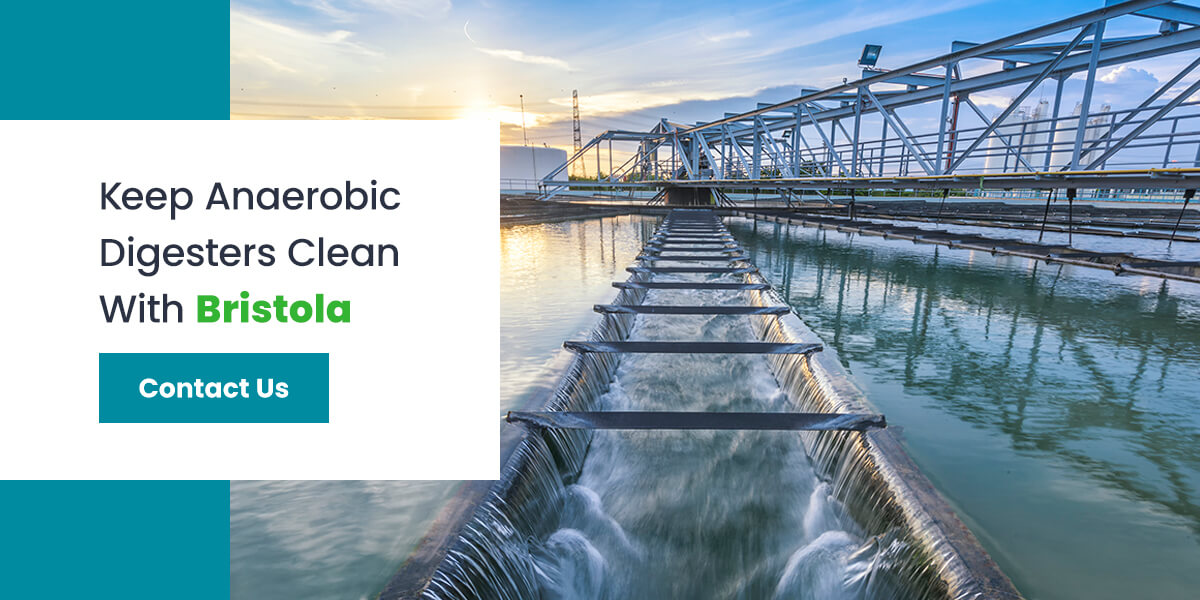
 Types of Anaerobic Digesters
Types of Anaerobic DigestersAll anaerobic digesters are designed to perform the same basic task — break down organic matter through anaerobic digestion to produce biogas, a mixture of gases created when waste decomposes, which serves as a renewable energy source. However, different types of digesters achieve that objective in different ways. Ultimately, digesters can feature subtle differences in construction and material handling techniques that affect the way they function.
The sections below will go over the distinguishing characteristics of anaerobic digesters, some specific types of anaerobic digesters and their common uses. Keep reading to learn more about the kinds of anaerobic digesters available and how to maintain them for optimal performance.
These systems are constructed for numerous reasons and are distinct in many different ways. This section describes some of the main differences among types of anaerobic digesters. The main differences include temperature, feedstock variation, flow and moisture content.
An anaerobic digester is built to run at particular target temperature ranges because different types of anaerobic microbes thrive in different temperature zones. Typically, the temperature range for mesophilic anaerobic digestion is between 86 and 100 degrees Fahrenheit, while the range for thermophilic anaerobic digestion is between 122 and 140 degrees Fahrenheit.
Usually, thermophilic anaerobic digestion is necessary for greater pathogen kill. The higher temperature range produces Class A Biosolids, which can be legally used as fertilizer on farms or commercial vegetable gardens and sold for use as compost or fertilizer for home gardens. While thermophilic digesters take less time to process feedstocks, they often come with higher costs and may be challenging to operate.
On the other hand, mesophilic anaerobic digesters are generally easier to operate and maintain. However, a mesophilic digester does not produce sufficient pathogen kill to generate Class A Biosolids.
Different anaerobic digesters are designed to process various types of feedstock. Some digesters are even designed to process multiple feedstocks, which is known as co-digestion. Some feedstocks may also need or benefit from pre-processing measures before digestion, such as screening, blending or thermal conditioning.
For batch digesters, every feedstock is loaded at one time. After loading, digestion occurs within a set period of time before the digester gets emptied and reloaded manually. For a continuous flow digester, the feedstocks are constantly fed into the digester, and the digested material gets continuously removed after digestion.
The feedstocks' moisture content classifies it as wet or dry. Known as a low solids anaerobic digestion system, wet digesters are more common than dry and usually process feedstock with less than 15% solids content. These types of feedstocks are most often in slurry form and able to be pumped.
A dry digester, also referred to as a high solids anaerobic digestion system, typically processes feedstock with a solids content higher than 15%. These kinds of feedstocks are commonly described as stackable.
Now that you know how anaerobic digesters can vary, it's time to discuss the specific types of anaerobic digesters available. In general, there are three main types of anaerobic digesters — passive systems, low rate systems and high rate systems. Within these broad categories, you'll find different types of anaerobic digesters useful for different purposes.
Below, you'll learn more about the variations of passive systems, low rate systems and high rate systems.

These systems refer to when biogas recovery is added to an existing treatment component. The most common digester in a passive system is a covered lagoon. This system capitalizes on the low-maintenance nature of a lagoon to help capture biogas under an impermeable cover. Most covered lagoons follow a two-cell system, enabling the lagoon to serve as a storage space and a treatment system.
In a two-cell covered lagoon, the first cell is covered, while the second cell is left uncovered. The level of liquid in the first cell remains steady to promote manure breakdown and the liquid level in the second cell fluctuates to create storage. Because covered lagoons are not heated, temperatures follow seasonal patterns.
It's possible to store sludge in covered lagoons for up to 20 years, meaning methane-forming microorganisms can also stay in covered lagoons for up to 20 years. In addition, much of the fertilizer nutrients, such as phosphorus, can also get trapped in a covered lagoon for decades. This tendency to retain substances makes regular cleanings critical for covered lagoons.
Only professionals can perform a covered lagoon cleaning. Ideally, anaerobic digester cleaning services can clean the storage portion of the covered lagoon without removing its contents, halting production or endangering anyone's safety. Bristola has developed an innovative solution by using sonar robotic vacuums to clean the covered lagoon without shutting down the system.

An anaerobic digester qualifies as part of a low rate system when the manure flowing through the digester serves as the main source of methane-forming microorganisms. These low rate systems can feature different types of anaerobic digesters, which are discussed in greater detail below.
Essentially, a complete mix digester is a tank that heats manure and mixes it with an active mass of microorganisms. Any incoming liquid displaces the digester's current volume, allowing an equal amount of liquid to flow out of the digester. Along with the displaced liquid, methane-forming microorganisms flow out of the digester.
Here, liquids remain in the complete mix digester for about 20-30 days, which maintains biogas production effectively. However, retention times may be shorter for thermophilic systems. Throughout the retention period, the digester can be either continuously or intermittently mixed, meaning the tank gets stirred during feeding and occasionally in between feeding times.
In some cases, the process occurs in more than one tank. For example, acid formers sometimes break down manure in one tank, followed by methane formers converting organic acids to biogas in another tank. Generally, complete mix digesters operate best when manure contains 3-6% solids. As lower solids levels correlate with greater volume, a larger digester must retain the microbes longer.
The concept of a plug flow digester is similar to a complete mix digester in that manure flows into the digester and displaces the digester volume, causing an equal amount of material to flow out of the digester. However, the manure within a plug flow digester includes contents thick enough to prevent particles from settling at the bottom.
Minimal mixing occurs with a plug flow digester, making the manure move through the digester as a plug. These digesters are best for manure with solids as high as 20%, meaning extra material may need to be added to manure designated for a plug flow digester. An increase in biodegradable material results in more biogas.
The recommended retention time for plug flow digesters is about 15-20 days. Like all anaerobic digesters, plug flow digesters should also be cleaned routinely to keep sediment from building up and interfering with the quality of the liquids. Bristola's liquid tank cleaning services provide a feasible way for organizations to have their digesters cleaned without halting operations.

Alternatively, high rate systems confine methane-forming microorganisms within the anaerobic digester to boost efficiency. More specifically, the following anaerobic digesters are commonly associated with high rate systems.
Known as contact stabilization digesters, anaerobic contact digester systems have to do with solids recycling. The digestion time can be decreased by returning some of the active organisms to the anaerobic digester. A plug flow system can achieve that advantage by pumping some of the effluent toward the front of the digester. On the other hand, complete mix digesters involve solids settling in an external clarifier before the microbe-rich slurry gets recycled back into the digester.
At its most basic, a fixed film digester is a column filled with media, such as small rings of plastic or wood chips, that methane-forming microorganisms grow on. In this case, manure liquids pass through this media, coating the media in a slimy growth known as biofilm. This type of digester is also called an anaerobic filter or attached growth digester.
The retention time for fixed film digesters is relatively short — sometimes less than five days. However, manure solids can occasionally plug the media, requiring professional attention before returning to its usual processing. For this reason, this type of system needs regular anaerobic digester cleaning to remain efficient and effective.
This type of digester involves suspending microbes in a continuous upward flow of liquid. The flow can be modified to let smaller particles wash out while keeping larger particles within the digester. Then, microorganisms create biofilms around the large particles and methane formers remain in the digester.
Certain suspended media digester designs include an artificial media like sand for microbes to produce more biofilm. These are referred to as fluidized bed digesters. Along with incorporating fluidized bed digesters, effluent is sometimes recycled as a way to maintain a steady upward flow.Sequencing Batch Reactor Digester.
This type of anaerobic digester is a specific version of an intermittently mixed digester that's well-suited for extremely dilute manures. In an anaerobic sequencing batch reactor (ASBR) digester, methane-forming microorganisms get stored via settling solids and decanting liquid. This process includes four phases.
During the fill stage, the ASBR digester is fed. If filled with enough active microbes, an ASBR digester may produce biogas with completely soluble organic liquids. Next, the microbes and manure get mixed together in the react phase. This phase is quickly followed by the settle stage, which involves the solids being settled. Finally, effluent is drawn off during the decant stage. The ASBR digester may repeat the cycle up to four times per day, resulting in almost constant gas production.
The liquid retention time for an ASBR digester may be as short as five days. This quick turnaround calls for frequent liquid tank cleaning to remove sludge and enable the ASBR digester to operate at its full capacity. The zero-human entry Submersive Robotic Cleaning System from Bristola cleans the liquid storage facility without interfering with the digester's everyday production.
The following sections discuss anaerobic digesters commonly used for farms, water resource recovery facilities and manufacturing plants.
An on-farm digester can add considerable value to farms and their surrounding communities. These digesters can aid farmers in managing nutrients, reducing odors and generating extra revenue. Most often, dairy, poultry and swine farms include an anaerobic digester of some sort. In addition to animal waste, on-farm digesters can accept outside food waste as feedstock.
The most common on-farm digesters include:
The type of anaerobic digester found on a farm is usually determined by the farm's manure management practices and the kind of animal waste available to feed into the digester. Typically, the biogas produced from the anaerobic digester systems is used for generating electricity, providing combined heat and power or fueling furnaces or boilers.
A water resource recovery facility serves to produce clean water, recover nutrients and reduce the community's dependence on fossil fuel by generating renewable energy. These facilities rely on anaerobic digesters to assist in their operations. Primarily, digesters treat wastewater solids, making them subject to EPA biosolids regulations.
To comply with regulations and fit with the facility, digesters at water resource recovery facilities can vary in the following ways:
Depending on a specific water resource recovery facility's needs, it could require any type of anaerobic digester. Currently, more than 1,200 water resource recovery facilities in the country use anaerobic digesters to produce biogas by treating wastewater solids. Many of them use the biogas as an energy resource for generating electricity or heat, which can be used for operations at the facility, sold to the grid or injected into natural gas pipelines.
Known as stand-alone digesters, anaerobic digesters made for manufacturing plants or processing plants accept feedstocks from one or more sources for a tipping fee. These types of digesters can process industry-specific wastes, manage residential food waste or operate as community-based operations or organics recycling businesses.
Frequently, stand-alone digesters process food waste as their feedstock. However, some stand-alone digesters are designed to co-digest other organic materials like manure, yard waste and wastewater solids. Many anaerobic stand-alone anaerobic digesters are high rate systems to assist with co-digestion and increase methane production from difficult-to-digest or low-yielding materials.

Any type of operation with an anaerobic digester needs to have its digester cleaned routinely. Regardless of what type of anaerobic digester is on the grounds, regular anaerobic digester cleaning is imperative. Bristola offers professional digester cleaning services to ensure digesters are clean, well-maintained and able to perform at their full capacity.
Bristola services anaerobic digesters with a cutting-edge, zero-human entry Submersive Robotic Cleaning System that uses sonar robotic vacuums to clean tanks without removing their contents, halting production or risking human life. Bristola's unique manhole cover technique replaces the tank's existing cover to allow the robotic vacuums to enter without removing the cover.
Choosing the Bristola Submersive Robotic Cleaning System enables you to clean your anaerobic digester without shutting down your facility. In this way, our services are hassle-free and cost-effective. Additionally, our full-service system will collect data about your tank to evaluate its condition and performance.
We also offer a unique entry portal that is placed on the manhole of tanks. This valve will allow us to easily re-enter and service your tank in the future.
Contact Bristola today to learn more about our Submersive Robotic Cleaning System or schedule a demo.